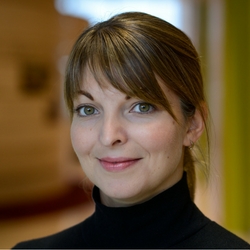Caroline Laplante PhD

Bio
Caroline Laplante joined NC State in January 2017 as a Chancellor’s Faculty Excellence Program cluster hire in Modeling the Living Embryo. As an assistant professor in the Molecular Biomedical Sciences Department at the College of Veterinary Medicine, she will focus on uncovering the complex molecular organization and dynamics of biological contractile structures in single cells and in developing organisms. As a quantitative cell and developmental biologist, Laplante answers these fundamental questions using a combination of genetics, quantitative fluorescence microscopy and high-speed super-resolution imaging in live cells and tissues.
Laplante trained as a biochemist and obtained her Ph.D. in biology from McGill University. During her doctoral studies, she discovered an essential role for the differential expression of the cellular adhesion protein Echinoid in the polarized assembly of the contractile leading edge in the migrating dorsal epithelium during embryogenesis in Drosophila. Her postdoctoral work challenged commonly accepted notions about the cytokinetic contractile ring essential for cell division in animals, fungi and amoebas. She discovered that not one, but multiple myosins function to generate the forces necessary for cell division and characterized the distinct role of these three myosins during the assembly and constriction of the contractile ring in fission yeast. Laplante adapted high-speed Fluorescence PhotoActivated Light Microscopy (FPALM) to the study of live fission yeast cells. With this technique, she obtained quantitative images of the cytokinetic apparatus at unprecedented resolution. She discovered that cytokinetic protein assemblies called “nodes” are the basic unit of constriction of the contractile ring in fission yeast, and built a molecular model of the protein organization within the node.
Area(s) of Expertise
COMPUTATIONAL BIOLOGY AND BIOINFORMATICS
Our research applies precision measurements of molecular, cellular and tissue dynamics in living embryos, along with computer simulation and modeling, to understand the development, growth and diversification of plants and animals.
Publications
- The Myosin-V Myo51 and Alpha-Actinin Ain1p Cooperate during Contractile Ring Assembly and Disassembly in Fission Yeast Cytokinesis , JOURNAL OF FUNGI (2024)
- Actin-Microtubule Crosstalk Imparts Stiffness to the Contractile Ring in Fission Yeast , CELLS (2023)
- Microtubule competition and cell growth recenter the nucleus after anaphase in fission yeast , MOLECULAR BIOLOGY OF THE CELL (2023)
- Imp2p forms actin-dependent clusters and imparts stiffness to the contractile ring , MOLECULAR BIOLOGY OF THE CELL (2022)
- Laser ablation reveals the impact of Cdc15p on the stiffness of the contractile ring , MOLECULAR BIOLOGY OF THE CELL (2022)
- Host-Pathogen Interactions of Chlamydia trachomatis in Porcine Oviduct Epithelial Cells , PATHOGENS (2021)
- Molecular organization of cytokinesis node predicts the constriction rate of the contractile ring , JOURNAL OF CELL BIOLOGY (2021)
- Building the contractile ring from the ground up: a lesson in perseverance and scientific creativity , Biophysical Reviews (2018)
- Resolving single-actin filaments within the contractile ring of fission yeast , PROCEEDINGS OF THE NATIONAL ACADEMY OF SCIENCES OF THE UNITED STATES OF AMERICA (2018)
- Response to Zambon et al. , Current Biology (2017)
Groups
- Research Area of Emphasis: Computational Biology and Bioinformatics
- CVM
- Developmental Biology
- CVM: Focus Area
- Focus Area: Food Animal
- Focus Area: Graduate Cell Biology
- Molecular Biomedical Sciences: MBS Faculty
- Molecular Biomedical Sciences: MBS Researchers
- CVM: Molecular Biomedical Sciences
- CVM: Research Area of Emphasis